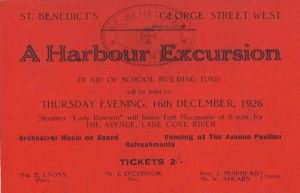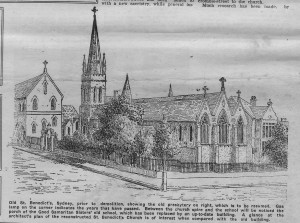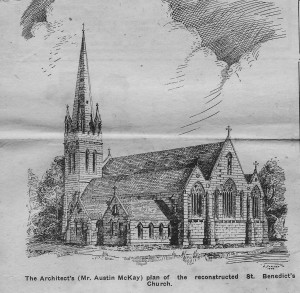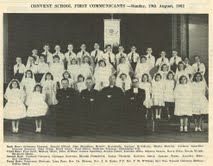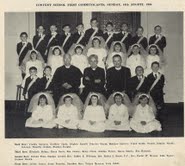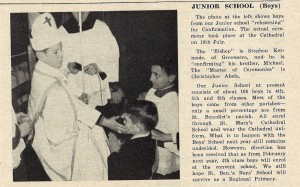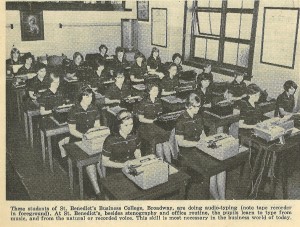Timeline
1836
13 January
Fr McEncroe applies to the colonial government for a grant of land.
18 January
The application is granted and interview is sought.
14 March
The Colonial Secretary advises the approval for the appropriation of one of four vacant allotments on Parramatta Road, near Cooper’s distillery. Representatives of the diocese are advised to select their allotment.
31 March
Governor Bourke makes a grant of land “on the Parramatta Road near Cooper’s Distillery, for the purpose of a Roman Catholic School and for use as a chapel”.
14 August
Having been advised that the first site selected for St Benedict’s was not suitable, the Colonial Secretary approves Fr McEncroe’s request for a portion of ground at the corner of Parramatta Street and Botany Bay Road, in lieu of the former allotment in Abercrombie Palce. The Colonial Secretary also agrees to a portion of ground at the rear of Abercrombie Place being granted as a site for a school.
December
The temporary chapel is almost complete; a brick structure 80’ long and 30’ wide, solidly built with an arched ceiling of lath and plaster. It is noted that it is an ornament to the neighbourhood.
1838
A small chapel, used as a school on weekdays, is opened.

Detail of 1838 map of the City of Sydney showing the first chapel on the current site of St Benedict’s.
1839
The Catholic Magazine (1840, p. 383) reports that at the temporary chapel “in Abercrombie Place” 220 people are in regular attendance. Communicants per month are 64. At this time the entire population of the colony of New South Wales is 101,904; 40,000 of whom live in Sydney. The Catholic population is 20,000; 14,000 of whom live in Sydney.
1841
20 June
Bishop Polding meets the renowned Gothic revival architect Augustus Welby Pugin at the dedication of St Chad’s Cathedral in Birmingham. He asks him to supply some plans which could be used for urban and rural churches in Australia. These arrive in 1842.
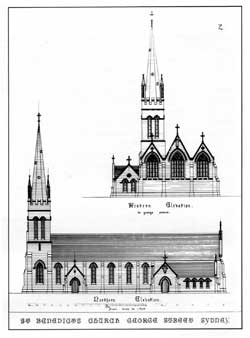
Architectural drawings showing elevations of St Benedict’s Church.
1842
A “catholic chapel” is clearly marked on a “plan of part of the south end and suburbs of the City of Sydney” published in this year. It sits on Parramatta street (now Broadway), between the Brisbane Distillery and Kent’s Brewery.
1843
December
Tenders are called for the erection of a “church (St Benedict’s) in stone as well as brick”. By the end of this year the congregation has saved £300 towards the building of the church.
1845
21 July
The foundation stone of St Benedict’s is laid by Archbishop Polding. Three thousand people attend the ceremony including the missionary bishop Epalle and his priests. £305 is collected on the day towards the building of the church. A brass plate with a Latin inscription is placed on the foundation stone reading:
John Bede Polding, Archbishop of Sydney, laid the corner stone of this Church, dedicated to Almighty God, in honour of St Benedict, on the 21st day of July 1845, in the Pontificate of Gregory XVI, and the 9th year of the reign of Victoria, Queen of Great Britain and Ireland, Sir George Gipps, Kt., being Governor of the Colony. John Morris, builder.
St Benedict’s is the third Catholic church to be built in the city of Sydney, after the Cathedral and St Patrick’s Church Hill.
1846
4,000 Catholics are recorded in the parish and the annual subscription amounts to £800. The temporary chapel cannot hold the people for Mass and the Office and as many as 70 people have to kneel outside (Morning Chronicle, 27 May 1846).

Archbishop Polding and the clergy of Sydney at the 1844 Council. Pictured are three men who became Parish Priest of St Benedict’s: Fr Timothy McCarthy (back row far left), Fr Dwyer (near the edge of the curtain on the left) and Dean Edward O’Brien (to the left and behind the short, bearded figure standing at the right).
1850
18 January
Six bells arrive in Sydney for St Benedict’s, cast by Charles and George Mears and Stainbank of the Whitechapel Bell Foundry, London, in 1849. Bells 1 and 2 are named in honour of the first and third Archbishops of Canterbury: St Augustine and St Mellitus. The other bells honour St Patrick (3), St Benedict (4), The Blessed Virgin Mary (5) and St John the Baptist (Tenor).
12 December
Archbishop Polding dedicates St Benedict’s peal of bells.
“As soon as all things were prepared. His Grace Archbishop Polding, attended by BB Austin Sheehy and Felix Sheridan as Deacon and Subdeacon proceeded to the place where the bells were hung; and after an appropriate instruction explanatory of the ceremonies, commenced the consecration. A numerous concourse of people was in attendance… After the ceremony the large Bell was raised to its place in the tower amidst the cheers of the spectators.” (Journal of St Mary’s Monastery)
The Journal of St Mary’s Monastery also notes in 1850 that there arrived “a set of brass candlesticks designed by Pugin and bought for St Benedict’s” (p. 260).
15 December
St Benedict’s new peal of bells rings for the masses of Christmas day and is clearly heard in the gardens of St Mary’s cathedral.
1851
The number of parishioners at St Benedict’s is depleted on account of the gold rush. Money from the goldfields, however, enables the building of the church to progress with greater speed. “At this period the church ended where the sacristy now stands, the altar being in a direct line with the sacristy: in fact, all the priest had to do was to walk on to the altar. The work was done by day labor, and this cost the parishioners a tremendous lot of money. The men employed by Father Corish suffered from ‘go slow’ methods, and as their wages averaged about 30/ to 32/ a day, no one distressed himself with work.” “Our Coadjutor-Archbishop: St. Benedict’s Story”, The Freeman’s Journal, 12 October 1922.
1 January
The bells of St Benedict’s and St Mary’s Cathedral announce the new year by ringing from midnight until 5am.
1852
The church is completed.
1853
The parish’s statue of St Benedict is finished in this year. It is the work of Dom John Soubellion, a Benedictine who had come to Sydney from Solesmes in 1848.
16 January
A major fire breaks out in the neighbouring Tooth’s Brewery. The newspapers report that “a number of persons made their way into the cellars, an extensive range of which runs under the building where the fire was raging, and drank to excess of whatever they could find.”
1854
Fr Corish establishes the first brass band at St Benedict’s. Bass Hodge, Dick Seymour and a man named Sykes are the instructors of this band.
1856
8 December
The spire of the church is completed. An inscription is placed at its base:
This spire was finished on the Feast of the Immaculate Conception, A.D.1856, under the superintendance of the Rev. M. Corrish, O.S.B., Polding, Archbishop of Sydney.
Later reports on the history of the church note: “The worthy priest [Fr Corish] was fortunate in securing an excellent man by the name of Nicholas, a Greek, to erect the spire.” “Our Coadjutor-Archbishop: St. Benedict’s Story”, The Freeman’s Journal, 12 October 1922.
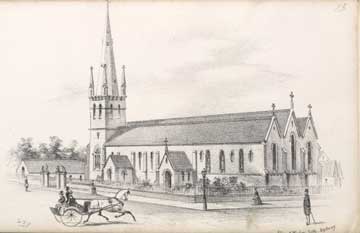
St Benedict’s Church, Parramatta St, Sydney 1856 litograph by S. T. Gill Image courtesy of the National Library of Australia NLA.PIC–AN7537497
The dogma of the Immaculate Conception of the Blessed Virgin Mary was solemnly defined in 1854. Bishop Polding was Australia’s representative at the promulgation of the dogma in Rome during the First Vatican Council. He returned to Australia in 1856 and in December of that year the Solemnity of the Immaculate Conception was first celebrated in Australia. The Pope declared a jubilee year in honour of the Immaculate Conception in 1857 and the Australian opening of this year was marked at St Benedict’s with a Solemn High Mass on 3 May. So the inscription in the spire of St Benedict’s about its completion on the feast of the Immaculate Conception records a particularly historic and early connection between the parish and this great feast of Our Lady.
1858
“Bell-ringing was introduced in St. Benedict’s about the year 1858 by John Henry Playford, an Englishman. He arranged to teach seven youths of the parish the art of bell ringing. The names of the seven aspirants were Thomas Hyndes, M. McNamara, John Cotter and Michael Condon (formerly the well-known potter of Glebe).” “Our Coadjutor-Archbishop: St. Benedict’s Story”, The Freeman’s Journal, 12 October 1922.
Fr Corish establishes a Young Men’s Society in the parish. Meetings are held every Sunday evening after Vespers. Membership of the Society reaches over 600. Caroline Chisholm lectures to the Society and her son, A. J. Chisholm, eventually becomes President of it in the early 1860s. A brass band develops from the Society and its plays in this year for the laying of the foundation stone of St John’s College at the University of Sydney. This is the second brass band established by Fr Corish, an earlier one having being established around 1854. A Dutchman named Van de Stadt, who is organist of St Benedict’s, also acts as bandmaster.
1859
15 May
Though the church is not completed, it receives a solemn blessing from the Archbishop.
September
Fr O’Neill is appointed as assistant priest to Fr Corish.
1861
July
Fr John Dwyer is appointed assistant priest in place of Fr O’Neill.
August
The stained glass windows in the church are completed, to designs by Fr Curtis. Other decoration on the panelling of the Sanctuary is also completed. The Catholic press reports “the decorations on the wall at the back of St Benedict’s…have been completed from designs, and under the direction of Father Curtis…The panelling is executed n red diapered patterns upon a white ground, with the pax and other symbolical devices in gold and colors in the centres, and the pediment borders, and the framework of the paintings in blue upon a white ground, with the tracery of the frames, which are Gothic-shaped, in gold with red borders. The cresting in the same style, but of richer design and a greater variety of color is employe, the differing compartments being divided by bands of gold surmounted by fleur-de-lys forming crosses.
1862
24 February
St Benedict’s is the first Catholic church in Australia to be consecrated.
The ceremony of consecration begins at 7 a.m. in the morning on the feast of St Matthias and is performed by Archbishop Polding. The Pontifical High Mass which then follows is sung by Dr Quinn, the Bishop of Brisbane, with Polding presiding from the throne. Archpriest John Joseph Therry preaches the sermon, taking as his text Matthew 11: 25–36. Entrance is by paid ticket only.
The Freeman’s Journal notes: “To meet the necessary expenses of this solemn ceremony, the tickets of admission will be 10 shillings each… A pamphlet containing an English translation of the whole of the magnificent Consecration Service may be had at the doors of the Church, and also at St Mary’s and Dolman’s, Pitt-street, price one shilling each.” Relics placed in the High Altar are those of St Peter, St Francis Caracciolo, St Pius V, St Amarina and St Anralia. These are carried around the church as part of the ceremony “in a magnificent relic-bier of white silk trimmed with gold and surmounted by a crown.”
The High Mass concludes at 3.15 p.m., with the entire service taking a little less than eight hours. The music for the ceremonies is especially praised: the Ordinary of the Mass being Mozart’s “Spaur” Mass in C, except for the Credo, which is from Haydn’s St Cecilia’s Mass. The offertory motet is Pergolesi’s Sanctum et terribile.

View of the High Altar showing original sanctuary wall paintings and tracery.
St Benedict’s school becomes a training school for Catholic teachers from this time. “Among the teachers at the old school were Brothers Carroll and Larter in the ‘sixties. The next teacher was Jeremiah O’Brien, who had previously been teaching a denominational school in Macquarie street. He taught the boys while Mrs. Rice looked after the girls. “Jerry”, as he was called by the boys, was succeeded by Darby Roche. He was followed by J. Moloney. Then came John Dwyer, who had been educated for the priesthood… Dwyer turned out some smart scholars, among them being the late Tom M. Slattery and J. Murtough.” “Our Coadjutor-Archbishop: St. Benedict’s Story”, The Freeman’s Journal, 12 October 1922.
1864
November
The bell-ringers of St Benedict’s place a tablet in the tower in “Memory of their late and beloved Pastor, the Rev. MA Corish OSB, who died the 30th June 1864.”
1869
The stained glass windows above the altars in the Sacred Heart and Lady chapels are installed. These are fabricated by a studio in Pitt Street, Sydney.
1870
A parishioner of St Benedict’s in 1940 recorded a lovely memoir of his father, who was active in the parish in the 1870s; ‘At that period my father held the license of the Australian Hotel…He had immigrated with two brothers (one aged twelve), and three sisters, from Ireland, and the sorrows of the Irish created a common bond of sympathy that gave courage and hope to the poor Irish strangers. In those days, St Benedict’s was the rendezvous of the immigrants; they gathered upon the roadway each Sunday after Mass, and discoursed upon distressful Ireland or the glory of their new found land…They were “townies” or shipmates, and they exchanged letters they had recently received from home, and they laughed or wept in accordance with the import of the message.The street facing the old Church, is a hallowed spot, it is a place where the news of the death of parents who had unceasingly sorrowed for their children in the strange land, was broadcasted…It is gratifying to see that the old stone church preserves its original fixtures, and as one reads of the labors of prelates, priests and parishioners associated with its origin and early history there comes the conviction that it will always endure because they set its foundation true and hard, for they watered it from the well-springs of their hearts’
1873
Statistics published by the Archdiocese of Sydney note that the Catholic population of the parish of St Benedict’s stands at 3,800 and that 500 students are enrolled at the school, with one lay teacher.
1875
24 July
New school buildings are opened.
1880
Mayor Harris of the City of Sydney inspects local church schools in the city region. It is difficult to judge how unbiased his final reports is, given the push by the government at this time against church schools in favour of public education. All of the church schools mentioned in the report are criticised for sanitation, ventilation etc. About St Benedict’s Church School, the report notes: “This building is divided, the boys being under the supervision of the Marist Brothers, while the girls and infants are under the control of the Department of Public Instruction. The appearance of the school-room was not prepossessing, as the boys’ department is divided from the girls merely by the suspension of a green baize curtain, which seemed extremely dirty. The boys’ school consisted of an average attendance of 280 daily, the girls’ school of 120, and the infants’ 242. The building itself is badly ventilated and dirty looking.”
Later in the year, the Good Samaritan Sisters take over the girls’ school at St Benedict’s. For three years the Sisters attended daily from their Mother House in Pitt Street. Eventually it is decided to provide the Sisters with a residence on site at the school.
1881
The Department of Education resumes land from the politician land dealer Andrew McCulloch and from the parish of St Benedict’s for the building of Blackfriars public school.
“There were many in the 1880s… who believed that… the construction of the Blackfriars school was a deliberate act of sectarian bigotry. This interpretation could only have been helped by the choice of G. A. Mansfield to design the buildings… Mansfield, who had designed schools in the sixties and seventies, favoured the Gothic, religious style. And so, cheek by jowl with the simple church school there arose a grand church-like state school. It generated a lot of anger. The Catholic Archbishop, Moran, recently arrived in the colony, visited the St Benedict’s school in September 1884 and was reported in the press as telling the children that he was ‘pained and grieved to see other schools encroaching on your ground.’ He alleged that the public school cut off light from the church school and summarised the construction of the school as ‘the cruelest act of intolerance… an act of unfairness and injustice and vandalism. The State has boundless resources at hand—its grounds not limited—yet it casts its eyes on your little home of religion and science.” (Shirley Fitzgerald, Beneath the Chippendale factory wall, Hale & Iremonger, Sydney, 1990, pp. 60-61)
A St Benedict’s conference of the Society of St Vincent de Paul is established within the parish.
1883
18 March
The foundation stone of the first convent of St Benedict’s is laid, on a piece of land in Abercrombie Street, adjoining the St Benedict’s School. The podium on which the Archbishop and other dignataries sat during the opening ceremony collapsed at the end of the Archbishop’s address. Fortunately, nobody was injured.
Statistics published by the Archdiocese of Sydney note that the Catholic population of the parish of St Benedict’s stands at 4,475 and that 895 students are enrolled at the school, with three Religious teachers.
The Department of Education makes a further small resumption of land belonging to the parish in order to complete Blackfriars public school. This encroaches on the newly built Presbytery stables and laundry.
1884
31 December
Archbishop Polding presides over a meeting of the Catholics of Sydney to petition the Government for a fairer distribution of the funds for public worship. He notes that at this time the Church has raised £300 for the erection of a church in Abercrombie street.
1888
12 February
Cardinal Moran lays the foundation stone for the new St Benedict’s School.
1891
January
In order to raise funds to complete the school buildings, the parish organises a ‘Shakespearean festival’ during January. It consumes the energies of the parish for the entire month and the Sydney Morning Herald reports on activities:
Considering the inclement weather, there was a large attendance last evening at the Shakespearean festival at St. Benedict’s Hall, Abercrombie-street. Given the commencement of these entertainments three weeks ago, they have become very popular in the district. There are eight fancy stalls, presided over by ladies attired in Shakespearean costumes, and everything connected with the entertainment is representative of the plays of Shakespeare. The hall presents a very pretty appearance, and the decorations have been artistically arranged under the supervision of the Rev. John Robinson. The various stalls and the costumes of the attendants are representative of the characters in Hamlet, Macbeth, As You Like lt, King Lear, Othello, Midsummer Night’s Dream, Romeo and Juliet, and the Merchant of Venice. The bazaar, which has been opened for the purpose of liquidating a debt of £7000 contracted in connection with the erection of the school buildings, will remain open for another week.
– ‘Shakespearean festival’, Sydney Morning Herald, 17 January 1891, p.10
1897
Incorrect chiming methods take their toll on the bells of St Benedict’s and by this date two bells (5 and 6) are broken.
1898
23 January
The newly built Presbytery is blessed.
1901
17 March
The remains of Archbishop Polding are transferred to St Mary’s cathedral. His coffin is initially placed in St Benedict’s and the solemn procession to the cathedral begins from the first church which he consecrated.
1902
The chapel of the Sacred Heart is dedicated to the memory of Father Francis Joseph Timoney, a previous parish priest.

Certificate awarded to student Kathleen McNamara in 1906.
1910
23 January
The Truth newspaper publishes a small article on the tradition of brass bands at St Benedict’s.
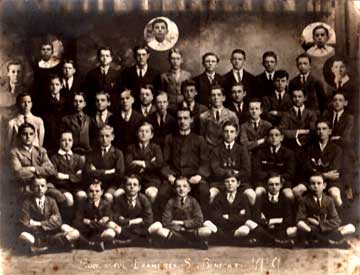
Successful examinees at the Marist run school at St Benedict’s, 1919.
23 January
The Garland publishes information about some new statues:

1921
30 November
Thomas Joseph Harrington is ordained a priest in St Mary’s Cathedral, Sydney. He was born in the parish, at 35 Abercrombie Street, the son of John and Margaret Harrington (nee Reily). He was baptised at St Benedict’s on 16 June 1897. Years later, Monsignor Harrington, as he became, received into the Church the mother of our future parish priest Fr Terence Purcell.
1922
Repair work is carried out on the spire and the crocket supporting the cross at the top is replaced with new stone.
May
The St Benedict’s Parish Chronicle is established with the aim of chronicling the ‘doings and activities of the various associations and societies which have been so instrumental in making St Benedict’s one of the most actively Catholic and spiritually successful parishes in the Archdiocese of Sydney’
21 October
A parishioner donates £50 for the conservation of the church bells. In March of the following year (1923) repairs are made to the belfry and on 26 March the bells are lifted and altered slightly. Restoration work to the tower continues throughout April and May, with brass bands added to the spire.
19 November
Archbishop Sheehan consecrates two replacement bells (5 and 6) for St Benedict’s. The bells, costing £450, are donated by Mr and Mrs Granville of the parish. The two bells are also cast by Meals and Stainbank, Whitechapel, London.
1924
By this date, the parochial district of “George Street West” is the second largest in the Archdiocese, after St Mary’s Cathedral. Synodal returns note that there were 4,763 parishioners in this year.
The Mission Cross (now in a chapel beneath the bell-tower) is moved to a position on the wall of the Gospel side of the church. This cross was donated by Mr McGirley of Redfern.
1925
June
A marble statue of the Sacred Heart is donated by Mrs Lyons and placed above the altar in the Sacred Heart chapel.
26 July
The modern complex of school buildings at St Benedict’s, including a convent for the Good Samaritan Sisters, a Brothers’ residence and hall, is blessed and opened by Archbishop Kelly.
8 November
St Benedict’s appears in a feature in the Sunday News on the “Beautiful churches of Sydney”. It is illustrated with an ink drawing by Lionel Lindsay.

1926
The new St Benedict’s hall is opened.
13 July
A new piano is purchased for the parish hall at the cost of £152.5.0
6 September
By Notice of Resumption published in the Government Gazette, the Sydney Council resumes “the property known as St Benedict’s Church and Presbytery in George Street West.”
1 November
The trustees of St Benedict’s submit a Notice of Claim and Abstract, claiming £10,000 for the land and £112,990 compensation for the buildings.
16 December
The parish hosts a harbour excursion on the steamer ‘Lady Rawson’ in aid of the School Building Fund.
1927
28 July
The City Solicitor submits his report on the title of St Benedict’s.
14 November
The city of Sydney valuers agree that £10,000 is a fair sum for land claimed, however a conference is held on this day to determine the question of compensation for buildings or the possible reinstatement of the entire building. The City Engineer and Surveyor submit a design for reconstructing and realigning the entire church, with the old East end facing Abercrombie Street. Numerous conferences are held throughout 1928 and 1929, but no real progress is made concerning the resumption.
1929
April
For the entire month the 11am High Mass and the Sunday evening devotions are broadcast on the radio from St Benedict’s.
September
A clock (now in the Vice Chancellery) is donated by the parishioner Mr Connors.
The Parish Chronicle notes that ‘an epidemic of ladies’-purse stealing at St Benedict’s and adjoining parishes was cured by the capture of a young woman at our church in early August. Before the magistrate she pleaded, according to the papers, ‘I stole to succour my starving child’.
1930
June
The Good Samaritan Sisters establish a kindergarten school at St Benedict’s.
1933
January
An organ fund is established in order to provide electrical pumping of the organ bellows.
The parish priest writes to Council for “any information you may give us as to when it is anticipated the resumption in this locality will be proceeded with.” He receives the reply that no work is intended in the immediate future.
November
The parish loses a case against the City of Sydney for rates owing for the years 1916–24 and has to pay £1,500.
1934
5 September
The Town Clerk convenes a conference between the Council’s representatives and the claimants for St Benedict’s.
1935
17 March
Former parishioner Norman Gilroy is consecrated bishop in St Mary’s Cathedral for Port Augusta in South Australia.
28 August
The boundary which the parish shares with St James, Forest Lodge, is redefined.
1936
10 October
The official geographic title of the parish is changed to “St Benedict’s Parish, Broadway” from “St Benedict’s Parish, George St West”.
November
Sister Mary Borromeo asks Dean Norris for permission to establish a commercial school at St Benedict’s ‘in addition to the usual curriculum at St Benedict’s convent schools’
1937
January
A business college is established for Catholic girls, although commercial subjects had been taught at St Benedict’s since the early 1920s.
1938
9 September
Council agrees to rebuild St Benedict’s church on the current site (at the cost of £40,623) rather than to compensate the parish for entirely demolishing the church (at the cost of £127,000). The widening takes about 26 feet of land and requires that the church be shortened by about two thirds of this amount, also taking a slice of the adjoining presbytery.
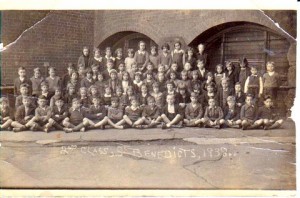
Photograph of students at St Benedict’s schools in 1938. This is one of the rare occasions on which the boy and girl students mingled, as socialisation betweent them was strictly forbidden. Some of the students who have been identified in this photograph include: 1st row: Cecil McDonnel, Ernie Wilbe, John Hannan, John McDonald,Charlie Dunn, Ray Taylor, George Bullivant, Burns, Dixon, Mitchell, Ernie Ectell, Neville Huddlestone; 2nd row: John O’Conner; 3 row: Mary Matha, Joan Ectell; 4th row: Harold Hardy, Jackie Tasker, Pat Dowsley,Carl Matha, Peter Conlon, Brennan, Tony Lye
1939
28 October
The last dance is held in the parish hall, which is converted into a church for the duration of the rebuilding of St Benedict’s.
19 November
The last Mass is held in the old church before demolition begins on the 21 November. The alterations to the church are supervised by architect Austin McKay.
1940
March
Bishop Gilroy succeeds Archbishop Michael Kelly as Archbishop of Sydney.
November
During this month the roof of the remodelled church is slated, lighting is installed and the mahogany ceiling is nailed on.
3 December
The statue of Christ the King is erected in a niche on Broadway.
1941
January
Dean Norris is made a monsignor in the papal honours list as the beginning of this year.
15 June
The rebuilt St Benedict’s is blessed by Archbishop Gilroy on a Sunday morning. Priests and parishioners rush to complete the painting and decoration of the church in time for the blessing. Father Macken, Provincial of the Vincentian Fathers, is invited to preach the special sermon at the opening. Seats are reserved in the church for the five Good Samaritan sisters and three Marist brothers teaching in the schools. The Children of Mary enter the church after the Archbishop and Clergy and the Holy Name Society form a guard of honour for the Archbishop.
August
The rebuilding of the church is completed. One of the builders later recalls that the builders at the time “were of the opinion that the present day information and history of the Church should be preserved in some way for the future. In the main wall of the north-eastern corner fronting the Broadway adjoining the Priest’s Sacristy we had built into the wall a copper box (sealed under a slight vacuum) the relative history of the Church as was known at that date. This information consists of the cost of the restoration. The names of the Priests who were officially in charge of St Benedict’s. The names of the stonemasons and tradesmen who were engaged in the demolition and the rebuilding of the Church, also an afternoon Sun Newspaper.”
7 September
The stonemasons John Garnett and Son, who did all the stone work for the remodelled St Benedict’s, donate to the parish a pair of carved holy water fonts in sandstone and marble.
1944
29 November
Archbishop Gilroy blesses and opens the newly built presbytery. The clergy moves in on 3 December.
1943
1945
8 November
The remodelled church of St Benedict’s is consecrated. The relics of the saints entombed in the altars include Saints Lucy, Clement and Theodosius (High Altar); Saints Lucy and Alexius (Lady Altar) and Saints Vincent and Pacificus (Sacred Heart Altar).
24 December
Pope Pius XII elevates Archbishop Gilroy, a former parishioner of St Benedict’s, to the Sacred College of Cardinals, making him the first Australian-born Cardinal in history.

Norman Cardinal Gilroy with former students of the St Benedict’s school on the occasion of its 75th anniversary in 1950.
1948
April
The last issue of the St Benedict’s Church Chronicle is published.
The parish priest of St Benedict’s, Monsignor Norris, is taken seriously ill and is admitted to St Vincent’s Hospital.
October
The memorial portrait of Cardinal Gilroy is completed. The portrait cost the parish £150.
24 December
The parish bulletin notes that this Christmas Eve will “be THE outstanding day in the history of St Benedict’s parish. His Emminence Cardinal Gilroy is this Christmas celebrating the silver jubilee of his ordination to the Priesthood. He is beginning the celebration in this church. As you are aware, it was in this parish that his parents were married. He himself was born in the parish, baptised, made his first Confession ahd Holy Communion, and receive the Sacrament of Confirmation in this church. He also received his early education in our school. Yesterday His Emminence informed the parish priest, Monsignor Norris, that because of all he owes to St Benedict’s, he would like to begin his silver jubilee celebrations in this church. So on Christmas Eve morning His Emminence will celebrate the 7am Mass in this church. He has expressed a wish that the whole parish join with him…On this morning also His Emminence will unveil the portrait of himself, erected by the parishioners. He will also lead the protest against the sacrilege committed in the church last Tuesday evening”
1949
23 January
Parishioners rally in the hall after the 11am Mass to protest against the persecution of the Church in Hungary, particularly after the arrest of the Primate of the Hungarian Church Cardinal Mindszenty, who was arrested on the 26 December 1948. A large protest of Catholic laity is later organised in the Sydney Domain on Sunday 30 January.
24 April
On this Sunday all parishioners are informed at Mass that ‘His Emminence the Cardinal has requested priests to remind Catholics that they are NOT to attend non-Catholic religious services at the cenotaph or Sydney Domain on Anzac Day on any pretext whatever. There will be a Solemn Requiem Mass at St Mary’s Cathedral at 10am on Anzac Day for the eternal repose of the souls of all those who lost their lives in World War I and II.’
1950
30 July
Cardinal Gilroy visits St Benedict’s to offer the 8am Sunday Mass. All ex-pupils of the Marist Brothers are invited ‘to join in thanking God for the blessings brought to the parish during the past 75 years by the Marist Brothers and their pupils.’ A Communion breakfast is held in the hall afterwards.
6 August
At all Masses at St Benedict’s on this Sunday it is announced that ‘Representatives of the Australian Communist Party are going about asking for the signatures of Catholics to a protest against the use of the atom bomb. Catholics are asked not to sign their names to this protest. Catholics seek true peace, not the false type being pedalled by the Communists.’
1955
May
A new parish newsletter, entitled St Benedict’s Parish News, begins to be published.
October
The sandstone of the tower of St Benedict’s, which was increasingly becoming stained and green, is cleaned in this month. It is an elaborate project that costs the parish £700. Erecting scaffolding around the tower also costs the parish £432
1957
January
The decoration of the cedar panels at the back of the Sanctuary is completed by the painting of some tracery upon them. This includes the cross of St Benedict with ‘Pax’ in the middle of each panel.
June
A circular tabernacle, donated by the Sweeney family, is placed on the High Altar.
1962
1964
5 April
The first Sunday evening Mass is celebrated at St Benedict’s, necessitating a discontinuation of the traditional Sunday night Rosary and Benediction.
7 May
For the first time parishioners are instructed to answer ‘Amen’ when they receive the Sacred Host during Communion.
28 June
The parish priest announces at the Mass on this day ‘On Sunday next (July 5th) and on the two Sundays following the first step will be taken to introduce English into the Mass. The Epistle and Gospel will be read in English. On the 4th Sunday in July, the second step will be taken-all the prayers said aloud will be in English. Even then, each parish will have still one all Latin Mass-ours will be the 9.30 (sung) Mass.’
July
For the first time English was introduced into parts of the Mass ‘the use of English will extend to all those parts of the Mass which are said in a loud voice, except the Preface…We hope to assist all present at Mass on the first few Sundays of the change over by having a priest in the pulpit during each Mass to explain.
2 August
Parishioners are instructed ‘The answer “amen” to the priest’s “The body of Christ” when receiving Holy Communion should be given before the tongue is put out to receive the Sacred Host.’
1965
A mission is held in the parish by the Redemptorist Fathers from 14 to 21 October.
1966
19 June
Parishioners are informed that at 9.30am this morning a liturgical festival entitled ‘To Liturgy through Music’ will be held at the Sydney Town Hall. This involves a Solemn Pontifical Mass at 3pm. ‘This is the first time ever Mass has been celebrated in the Town Hall.’
26 June
Parishioners are instructed to identify themselves on the Commonwealth census as ‘Catholic’ NOT ‘Roman Catholic’ by decree of the Cardinal.
28 August
Fr James Oliver, an ex-parishioner, is ordained a priest at the Redemptorist Monastery, Ballarat in Victoria.
1972
December
The business college at St Benedict’s is closed.
1973
2 September
The convent of the Good Samaritan Sisters at St Benedict’s is closed.
1974
25 December
The restoration of the bell tower is completed and the bells are pealed again for the midnight Mass of Christmas.
1976
28 March
Cardinal Freeman rededicates St Benedict’s peal of six bells, on the 125th anniversary of the consecration of the original bells.
1977
5 May
A notice appears in the Catholic Weekly stating: “Keeping alive its historic link with Archbishop Polding and early Benedictine life in Sydney, St Benedict’s Church is establishing a Liturgical Choir of men and boy choristers initially to sing Solemn Vespers (English) and Benediction (Latin) on the last Sunday of every month at 7.15pm commencing on 29 May.” School bursaries are eventually offered to four succesful boys.
1978
30 April
The restored organ of St Benedict’s is blessed by Archbishop James Carroll during Solemn Pontifical Mass. The choir of the nearby Anglican Church of Christ Church St Laurence provide the music for the Mass. The Sydney Organ Journal reported on the restoration (April 1978) ‘Pitchford and Garside are just completing restoration of the organ…Perhaps the most interesting feature [of the organ] is that the pitch of C is 540 cycles or ‘old philharmonic’ which is rarely found these days, even in many old instruments. This is the same as the former pitch of the Sydney Town Hall organ…The manuals are unusual in that their compass is only 54 notes…The electric blower was installed in 1941 and up until that time the organ was hand-blown. A new blower was installed by Pitchford and Garside in 1975.’ During this ceremony a new marble low altar is consecrated, commissioned from the Melocco Brothers in 1974. The tabernacle is also re-dedicated. This tabernacle was removed from the church during the 1950s and given away. Found at Villawood, it was restored to St Benedict’s through the efforts of Fr Purcell and architect Chris McGuirk.
1980
August
Sydney City Council workers make an unusual find while excavating old guttering on the corner of Buckland and O’Connor Streets. When one of the stone blocks forming part of the old guttering was upturned, it was found to be a foundation stone laid in 1901 by Cardinal Moran. Fr Boland wrote to the parish about this discovery: ‘The land on which Blackfriars now stands was once Church property, but was sold to the State School Board…The culprit was Dean O’Brien who defended his action from the pulpit. I cannot put a date to that. It would have been the 80s or 90s…My surmise is that the discovered stone belonged to a hall, probably built with the sale money and pulled down when Fr. Halpern built the present hall-school complex in the early 20s.’
1981
St Benedict’s school closes.
1985
21 July
St Benedict’s celebrates the 140th anniversary of its founding by Archbishop Polding.
1995
9 July
The 150th anniversary of the dedication and opening of St Benedict’s is celebrated.
2002
28 April
The church bells are rededicated by Archbishop Pell after being sent away to England a year before for retuning and modification.
2005
A significant year in the life of the parish. Fr Purcell retires as Parish Priest and Fr John Neill is appointed. Plans to combine a parish and university campus are realised, with students enrolling for the 2006 academic year.
The University of Notre Dame leases the buildings on the St Benedict’s site (except the church) and renovation work begins of all the buildings and the site. This includes a new slate roof on the church, carpeting the floor and re-positioning the pipe organ to its original front-facing position in the gallery. The presbytery is maintained in its original condition and is used as offices.
During the renovation work, masses are held in a room in an alleyway near Buckland Street.

2009
The City of Sydney funds 50% of the installation of a clarion stop to the pipe organ through a local community grant.
2010
May
Fr Michael de Stoop is officially installed as Parish Priest, having been in the parish for over a year as administrator.
2012
24 February
The 150th anniversary of the consecration of St Benedict’s is celebrated by Cardinal George Pell. The choir and orchestra perform the same mass setting that was used in 1862 (Mozart’s Missa Brevis in C, “Spaur Mass”).
2015
1 June
Fr Michael de Stoop is farewelled as Parish Priest. He is soon replaced by Fr Epeli Qimaqima as Parish Administrator.
October
Major renovation and cleaning of the stonework begins, starting with the bell tower; possibly the first such renovation in the church’s physical life. This work continues into 2016.
2016
4 December
A Mass is celebrated to mark the end of the recent major restoration project which had been jointly funded by the parish, UNDA and various benefactors.
2019
27 January
Fr Epeli Qimaqima is farewelled and Fr Dominic Murphy OP is appointed as the new Parish Priest, heralding a new era of management of the parish by the Dominican Order.
2020
25 March
The church is closed for all normal masses until further notice due to the Federal Government’s restrictions of gatherings during the COVID-19 pandemic. Weddings may have just five attendees while funerals are limited to ten people. The last time the church was closed for similar reasons was on 28 January 1919 due to the pneumonic influenza (Spanish flu).
June
Masses resume, but with a limit of just 50 attendees. Other parishioners might watch mass via the internet, as this recording from July 12 of St Benedict’s Feast Day: https://www.youtube.com/watch?v=_StABJGebl4
Bibliography
Fitzgerald, Shirley (1990). Chippendale: beneath the factory wall. Sydney, NSW: Hale & Iremonger.
